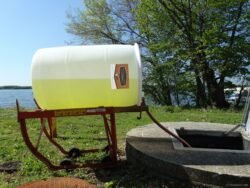Radiological Contaminants: Identifying and Managing Nuclear Hazards

Radiological contaminants are substances that emit ionizing radiation, posing potential risks to human health and the environment. These contaminants can come from various sources, including nuclear power plants, medical facilities, and naturally occurring radioactive materials. Exposure to radiological contaminants can lead to serious health effects, ranging from acute radiation sickness to long-term cancer risks.
Scientists and health professionals use specialized equipment to detect and measure radiological contaminants. This helps them assess the level of risk and decide on the best course of action. Governments and international organizations have set strict guidelines for handling and disposing of radioactive materials to protect public safety.
Efforts to clean up areas affected by radiological contamination often involve complex processes and can take many years. Experts work to remove contaminated soil, treat water sources, and safely store radioactive waste. Public awareness and education play a key role in preventing exposure and managing the risks associated with these hazardous materials.
Key Takeaways
- Radiological contaminants emit ionizing radiation and can harm health and the environment
- Special equipment and strict regulations help monitor and control these substances
- Cleanup of contaminated areas involves complex processes and long-term efforts
Understanding Radiological Contaminants
Radiological contaminants pose serious risks to human health and the environment. These radioactive substances can enter water supplies and ecosystems through various means, potentially causing long-term damage.
Types of Radiological Contaminants
Radiological contaminants come in different forms. Alpha particles are large and can’t travel far, but are harmful if inhaled or ingested. Beta particles can penetrate skin and clothing. Gamma rays are the most dangerous, able to pass through the body.
Common radiological contaminants include:
- Uranium
- Plutonium
- Radon
- Cesium-137
- Strontium-90
These elements emit ionizing radiation as they decay. Some have very long half-lives, remaining radioactive for thousands of years.
Sources and Causes of Radiological Pollution
Radiological pollution can stem from both natural and human-made sources. Natural sources include rocks and soil containing radioactive minerals. Radon gas seeps from the ground in some areas.
Human activities that can cause radiological contamination:
- Nuclear power plant accidents
- Improper disposal of radioactive waste
- Nuclear weapons testing
- Mining and processing of radioactive ores
Industrial processes using radioactive materials may release contaminants if not properly managed. Medical facilities can also be a source if radioactive materials aren’t handled correctly.
Health Risks Associated with Radiological Exposure
Exposure to radiological contaminants can lead to severe health issues. The effects depend on the dose and duration of exposure. Short-term effects may include radiation sickness, with symptoms like nausea and hair loss.
Long-term risks include:
- Increased cancer rates
- Genetic mutations
- Damage to organs and tissues
- Weakened immune system
Children and developing fetuses are especially vulnerable to radiation exposure. Even low doses over time can increase cancer risk. Proper safety measures and monitoring are crucial to protect public health from radiological contaminants.
Monitoring and Regulation
Strict standards and regular testing ensure safe drinking water. Government agencies enforce regulations to protect public health from radiological contaminants.
Standards for Radiological Contaminants in Water
The EPA sets Maximum Contaminant Levels (MCLs) for radiological substances in drinking water. These include limits for radium-226, radium-228, and uranium.
The MCL for combined radium-226 and radium-228 is 5 picocuries per liter (pCi/L). For uranium, the limit is 30 micrograms per liter.
These standards help water suppliers maintain safe levels of radioactive materials. They also guide treatment processes to remove contaminants when needed.
Radiological Testing of Drinking Water
Water systems conduct regular tests to check for radiological contaminants. The frequency depends on the water source and previous results.
Tests measure alpha and beta particle activity. They also look for specific radionuclides like radium and uranium.
Labs use specialized equipment to detect low levels of radioactivity. Results are compared to MCLs to ensure compliance.
If levels exceed limits, suppliers must notify the public and take corrective action.
Regulatory Bodies and Compliance
The EPA oversees drinking water safety at the federal level. State agencies often have primary enforcement responsibility.
Water suppliers must follow the Safe Drinking Water Act. This law requires them to test for contaminants and report results.
The Nuclear Regulatory Commission also plays a role in radiation protection. They set rules for handling radioactive materials that could affect water sources.
Suppliers face penalties for non-compliance. These can include fines and mandatory corrective actions.
Public water systems must provide annual reports on water quality to customers. These reports include information on detected radiological contaminants.
Mitigation Strategies
Dealing with radiological contaminants requires careful planning and specific actions. Key strategies include using specialized filters, following safety protocols, and having emergency response plans ready.
Radiological Water Filters and Purification
Radiological water filters are crucial tools for removing radioactive particles from water. These filters use materials like activated carbon or ion exchange resins to trap radioactive isotopes.
Some filters can remove up to 99% of certain radioactive elements. It’s important to choose filters certified for radiological contaminants.
Regular radiological water testing is needed to check filter effectiveness. Testing should be done by qualified labs using proper equipment.
Reverse osmosis systems can also help remove some radioactive particles. Boiling water alone does not remove radioactive contaminants.
Best Practices for Managing Radiological Risks
Proper protective gear is essential when handling radioactive materials. This includes lead aprons, gloves, and face shields.
Limiting exposure time and maximizing distance from radiation sources are key safety practices. Use remote handling tools when possible.
Regular training for staff working with radioactive materials is crucial. This should cover safety procedures and emergency protocols.
Proper storage and labeling of radioactive materials prevents accidental exposure. Use shielded containers and clear warning signs.
Emergency Responses to Radiological Spills
Quick action is vital in case of a radiological spill. The first step is to clear the area and prevent spread of contamination.
Alert the Radiation Safety Officer immediately. They will assess the situation and guide the response.
Use absorbent materials designed for radiological spills to contain the contamination. Do not use regular cleaning supplies.
Carefully document all steps taken during the spill response. This information is important for later analysis and reporting.
Proper disposal of contaminated materials is crucial. Follow specific guidelines for radiological waste management.
Community and Environmental Impact
Radiological contaminants pose serious risks to ecosystems and human health. These pollutants can persist in the environment for long periods, affecting plants, animals, and people in complex ways.
Effects of Radiological Pollution on Ecosystems
Ionizing radiation from radiological contaminants can damage DNA in living organisms. This leads to mutations and health problems in plants and animals.
Aquatic ecosystems are especially vulnerable. Radiological water pollution can concentrate in sediments and bioaccumulate up the food chain. Fish and other aquatic life may suffer reproductive issues or die off.
On land, radiation can stunt plant growth and reduce crop yields. Soil microbes crucial for nutrient cycling may decline. Animals may experience reduced fertility or shortened lifespans.
Long-lived radioactive elements like cesium-137 can contaminate areas for decades. This creates lasting changes in ecosystem composition and function.
Radiological Contaminants and Public Health
Human exposure to radiological contaminants can occur through air, water, food, and direct contact. Even low doses increase cancer risk over time.
Acute radiation sickness can result from high exposures. Symptoms include:
- Nausea and vomiting
- Skin burns
- Hair loss
- Organ damage
Children are especially vulnerable to radiation’s effects. Prenatal exposure may cause birth defects or developmental issues.
Contaminated food and water are major exposure routes. Proper testing and restrictions on contaminated products are crucial for public safety.
Mental health impacts often accompany radiological incidents. Fear and stress can harm wellbeing even when physical exposure is limited.
Technological Advances in Radiological Analysis
Recent innovations have improved radiological testing methods and water filtration techniques. These advances allow for more accurate detection and removal of radiological contaminants.
Innovations in Radiological Testing Methods
Ionizing radiation detection has seen major improvements. New portable devices can quickly identify radioactive materials in the field.
Advanced spectroscopy techniques provide more detailed analysis of radioactive isotopes. This helps determine the source and type of contamination.
Computer modeling now predicts radiation spread more accurately. This aids in planning emergency responses to radiological incidents.
Drones equipped with radiation sensors can survey large areas safely. They map contamination zones without risking human exposure.
Development of More Efficient Radiological Water Filters
Water treatment plants now use specialized filters to remove radioactive particles. These filters can trap particles as small as 0.1 microns.
Ion exchange resins selectively remove radioactive ions from water. They are highly effective for cesium and strontium contamination.
Reverse osmosis systems have been optimized for radiological decontamination. They can remove up to 99% of radioactive materials from water.
New carbon-based materials show promise for filtering radioactive elements. These include graphene and carbon nanotubes.
Automated monitoring systems continuously check water quality. They can detect even trace amounts of radioactive contamination.
Frequently Asked Questions
Radiological contamination poses risks to human health and the environment. Detection methods, health impacts, sources, and prevention strategies are key areas of concern.


